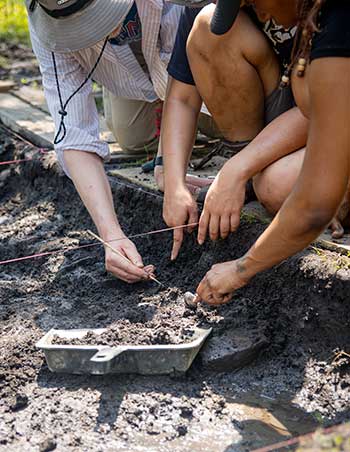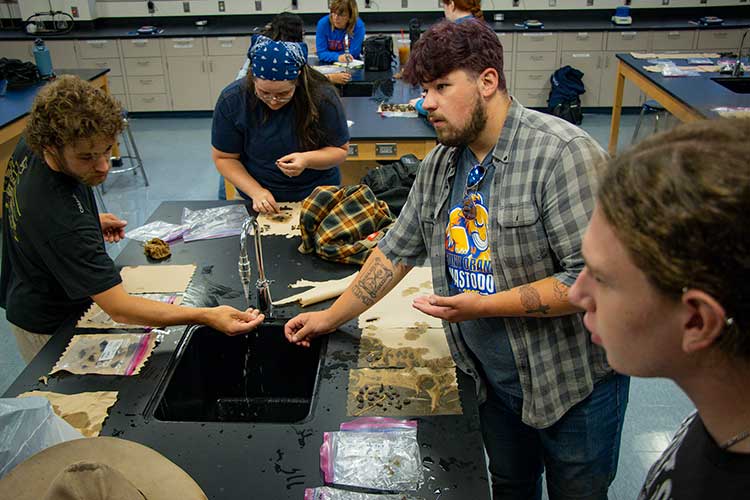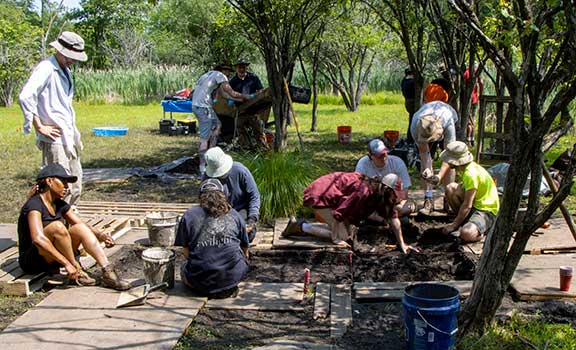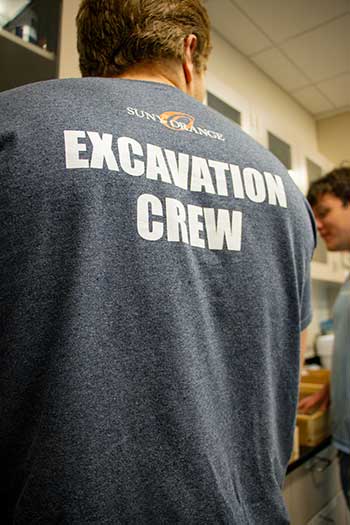2025 Excavation Crew
The Excavation Crew: Mastodon Dig 2025
The SUNY Orange course catalog describes ANT 104 as a hands-on archaeological field experience involving lectures, lab work, and 100 hours of digging, documenting, and mapping over four weeks. But for students in the 2025 session, working the same Scotchtown site where mastodon remains were unearthed during the Fall of 2024, that summary leaves something out. Many say the Summer session class offered far more than the brief overview suggests. In fact, most agree the most valuable takeaway is not about excavation techniques or fossil findings, but about the experience of working together.
Faculty
Dr. Cory Harris
Chair, Behavioral Sciences Department
Dr. Cory Harris joined the SUNY Orange faculty in 2007 and currently serves as chair of the Behavioral Sciences Department. He regularly teaches “Cultural and Social Anthropology,” “Archaeology and Prehistory,” “Human Evolution,” "Introduction to Sociology" and “Human Geography.” His research interests have largely focused on Southwestern archaeology, particularly the late precontact period in southern Arizona. Additionally, he is interested in archaeological method and theory, the sociology of science, and the socio-history of archaeological thought. He has conducted archaeological fieldwork throughout Arizona, New Mexico, Colorado, Northern Mexico and the tri-state area.
Anthony Soricelli
Instructor, Science, Engineering and Architecture Department
Anthony Soricelli brings a strong foundation in earth and physical sciences to SUNY Orange, with formal educational training from SUNY Dutchess, SUNY Fredonia, and Clemson University. His teaching spans introductory to advanced geology and physics, and his engagement includes active mentorship as advisor to the Geology Club as well as public science outreach. He’s a valued resource for both the College and wider community—especially in geological investigations like the Orange County mastodon find—striking a balance between scholarly rigor and hands-on, enthusiastic involvement.
Students
Liam Bartels
Wurtsboro, N.Y. (May 2025 graduate with a liberal arts degree with a biology track)
Currently completing his second degree at the College in history/anthropology, Bartels said, “I heard about this class while I was in Earth Science and strongly expressed my interest. It is such a rare opportunity and not at all a regular field course. This has just been astonishing. It’s not likely that at any other time in my life I will be digging up a mastodon rib. The details, the working with other people to dig up five-gallon buckets of dirt several times a day, then screening it and the geology testing--it has been like nothing else. Every aspect has been amazing and everyone works well together. With such an array of backgrounds and interests, it’s been interesting to see what we all bring to this experience.”
Carson Becker
Wallkill, N.Y. (Liberal arts with a geology track)
Becker shared that his history with the site dates back to his childhood and he passed down stories of the area once being a lakebed and farmland through the 1800’s. As a kid, he would look around in the woods for any signs of the past.
“And here I am, digging up a 13,000-year-old mastodon. I’m sitting with these bones and touching them and thinking, ‘This thing had a life and how did it get to be here?’ It’s just mind blowing.”
Asked how this project would relate to his future, Becker expressed his interest in the pairing of archeology with technology. “I hope to be someplace in between hands-on work and traveling the world to help discover more about our history. I love being out in nature. I’m interested too in the use of LiDAR (Light Detection and Ranging), a ground penetrating radar used to map areas by bouncing off of hard objects and giving a reading like those seen on a topography map.”
Sharing what aspects of the field work were not as expected, he answered, “I was surprised at how the shallow the bones were in the ground and their orientation.” Becker went on to explain in detail the position of the spine and that it was found in a way that may have indicated it was moved, perhaps by an animal drawn plow in the 1800’s but that theory leads to more questions. “We know that the water was not fast moving but why was everything laid out the way it was, how does it connect with our culture, our people and what was going on in the area.”
Brighton Blake
Westtown, N.Y. (Liberal arts humanities and social science)
Blake said he is considering changing his major based on the experience with the dig and this class.
“The whole experience, the educational aspect of this class, made me feel so prepared to be a part of this field.”
Talking about the extreme weather conditions the team faced, Blake said, “We were digging in extreme heat and then completing other tasks in the classroom when the rain came. I wasn’t expecting so much attention to detail with mapping and data recording. It is a lot more in-depth that expected, but in a positive way.”
Stephanie Caceres
Middletown, N.Y. (Liberal arts with a chemistry track)
“I was in Professor Harris’ anthropology class last semester and this opportunity was announced. I signed up and I have to say, I really didn’t think we were going to find anything. It’s a very slow process. The piece of spine we found took two days to uncover.”
Caceres explained that the digging part is done with a garden trowel turned on its side and is more scraping through the mud with a gentle touch. For her, the best part was meeting people. “Everyone has been fun to talk to during this opportunity of a lifetime. I want to be a medical examiner and will be transferring to University of Buffalo in August.”
It’s easy to make the leap about how learning methodical and meticulous investigation methods will carry forward into Caceres’ next chapter.
Aristu Easley
Chester, N.Y. (Liberal arts)
Easley is planning to transfer to an art school after completing four semesters at SUNY Orange.
“It has been really cool to find bones or some things in the dirt. But mostly, I really enjoy when we are all chatting together or when we find a live critter,” he said. “I have a sense of fulfillment when we are all working together, digging all these old bones out of the dirt and do a paleo dig. It is quite a sense of accomplishment.”
 Joe Ennis
Joe Ennis
Port Jervis, N.Y. (Liberal arts major with a history track)
“I was surprised that this was easier than I thought and we found more things than I expected. I have to say, I would have loved to find a tusk though. Screening had its ups and downs. Some days we would find things and others-- the mud just wasn’t cooperating.”
Both Ennis and Blake praised their professors for a memorable and educational experience that was hands-on and exceeded their expectations.
Gavin Gordocki
Pine Bush, N.Y. (Liberal arts math and science)
“Setting up the test units, the geology aspect, has really given me a better understanding of what we are doing. The mud was so hard to screen through. We had to use our hands to help, and it was very time-consuming. I also thought about digging as a kid and hoping to find something, and here I am excavating a mastodon site, preserving what we find and sending it to a museum. It is wonderful and anyone with any interest at all in prehistoric life or geology would enjoy it. This is one of the best experiences of my life.”
Anna Gravel
Newburgh, N.Y. (Visual Communications)
Gravel was taking an anthropology class when she found out about this elective and thought, “When will I ever have this opportunity,” before signing up. “In general, it’s been fun. It’s better than most classes because everyone really wants to be here. It’s more outside than a classroom setting and it is of course, a once-in-a-lifetime opportunity.”
Gravel said she was most surprised by how strongly the people want to be a part of this class and was not aware how detailed it was going to be regarding mapping things out using pen and paper.
Sadie Hankins
Greenwood Lake, N.Y. (Liberal arts with an anthropology track)
She was taking an anthropology class last Fall when she first heard about the jaw being found.
“This whole thing is just really cool,” she said. “The opportunity is incredible, and I am honored to be here. It’s just fun to live out your childhood dreams of digging in the dirt. For me, I was looking for unicorns and now, I’m finding things from 13,000 years ago. It just broadens your whole world. I’ve learned a lot. I didn’t know we would find this much. I mean the ribs. I can’t believe we found that, and I had a dream we found the tusks!”
Reflecting on what will stay with her, Hankins said, “The people will be the long-term memory for me. Everyone collaborates so well and in this rare opportunity that really adds to it.”
Kierra Moore
Cornwall, N.Y (Liberal Arts with an anthropology track)
“Professor Harris is my advisor, and he emailed me about this opportunity, but I couldn’t join immediately. I was put on a wait list and was able to join a little later.”
Asked what the best part of this experience has been, Moore shared without missing a beat, “The people. As much as I love digging up this mastodon, it really is the people and everyone being able to embrace the suck of it together (the weather, the bugs, the mud) and just lift everyone up. Professors Harris and Soricelli have been great.”
 Richard Neidermeyer
Richard Neidermeyer
Montgomery, N.Y. (Liberal arts)
Neidermeyer heard about this class from Professor Harris and immediately signed up for the local history and experience.
“I think it is great that we are finding actual bones. I thought we might just find fragments,” Neidermeyer shared. The process was a little slower than I expected at first.”
Planning to graduate from SUNY Orange next Spring, he is still exploring next steps but was asked how he thought this experience would help him in the future.
“This has really taught all of us how to work as a team, how to plan and determine what has to get done next,” he thoughtfully shared before adding, “but digging was the most fun.”
Gabrielle Scott
Newburgh, N.Y (Liberal Arts with a biology track)
“This must be one of the coolest things I have ever done, and I will not forget it,” Gabrielle Scott said, adding that the most surprising part of the experience was how much of the mastodon the group actually found and how she became more comfortable with the number of insects around the site.
“My favorite part of the dig was the amazing people in the class, which made the extreme heat more bearable,” she said. “Also, finding the vertebrae was exciting. It was amazing to see how the vertebrae were aligned.”
With a future goal of becoming a zoologist, Scott added, “I think this class gave me great experience being outside for long periods of time, dealing with bugs, working with a team, and having a field journal, all of which I would be doing in my career choice.”



